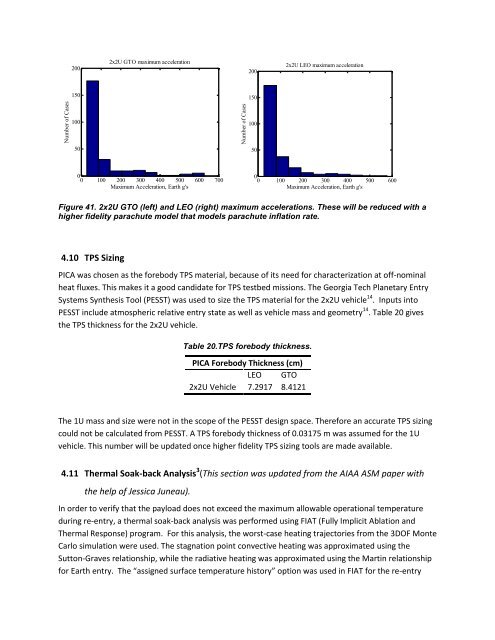SPORE Mission Design - Georgia Tech SSDL - Georgia Institute of ...
SPORE Mission Design - Georgia Tech SSDL - Georgia Institute of ...
SPORE Mission Design - Georgia Tech SSDL - Georgia Institute of ...
Create successful ePaper yourself
Turn your PDF publications into a flip-book with our unique Google optimized e-Paper software.
Number <strong>of</strong> Cases<br />
Number <strong>of</strong> Cases<br />
200<br />
2x2U GTO maximum acceleration<br />
200<br />
2x2U LEO maximum acceleration<br />
150<br />
150<br />
100<br />
100<br />
50<br />
50<br />
0<br />
0 100 200 300 400 500 600 700<br />
Maximum Acceleration, Earth g's<br />
0<br />
0 100 200 300 400 500 600<br />
Maximum Acceleration, Earth g's<br />
Figure 41. 2x2U GTO (left) and LEO (right) maximum accelerations. These will be reduced with a<br />
higher fidelity parachute model that models parachute inflation rate.<br />
4.10 TPS Sizing<br />
PICA was chosen as the forebody TPS material, because <strong>of</strong> its need for characterization at <strong>of</strong>f-nominal<br />
heat fluxes. This makes it a good candidate for TPS testbed missions. The <strong>Georgia</strong> <strong>Tech</strong> Planetary Entry<br />
Systems Synthesis Tool (PESST) was used to size the TPS material for the 2x2U vehicle 14 . Inputs into<br />
PESST include atmospheric relative entry state as well as vehicle mass and geometry 14 . Table 20 gives<br />
the TPS thickness for the 2x2U vehicle.<br />
Table 20.TPS forebody thickness.<br />
PICA Forebody Thickness (cm)<br />
LEO GTO<br />
2x2U Vehicle 7.2917 8.4121<br />
The 1U mass and size were not in the scope <strong>of</strong> the PESST design space. Therefore an accurate TPS sizing<br />
could not be calculated from PESST. A TPS forebody thickness <strong>of</strong> 0.03175 m was assumed for the 1U<br />
vehicle. This number will be updated once higher fidelity TPS sizing tools are made available.<br />
4.11 Thermal Soak-back Analysis 3 (This section was updated from the AIAA ASM paper with<br />
the help <strong>of</strong> Jessica Juneau).<br />
In order to verify that the payload does not exceed the maximum allowable operational temperature<br />
during re-entry, a thermal soak-back analysis was performed using FIAT (Fully Implicit Ablation and<br />
Thermal Response) program. For this analysis, the worst-case heating trajectories from the 3DOF Monte<br />
Carlo simulation were used. The stagnation point convective heating was approximated using the<br />
Sutton-Graves relationship, while the radiative heating was approximated using the Martin relationship<br />
for Earth entry. The “assigned surface temperature history” option was used in FIAT for the re-entry
















